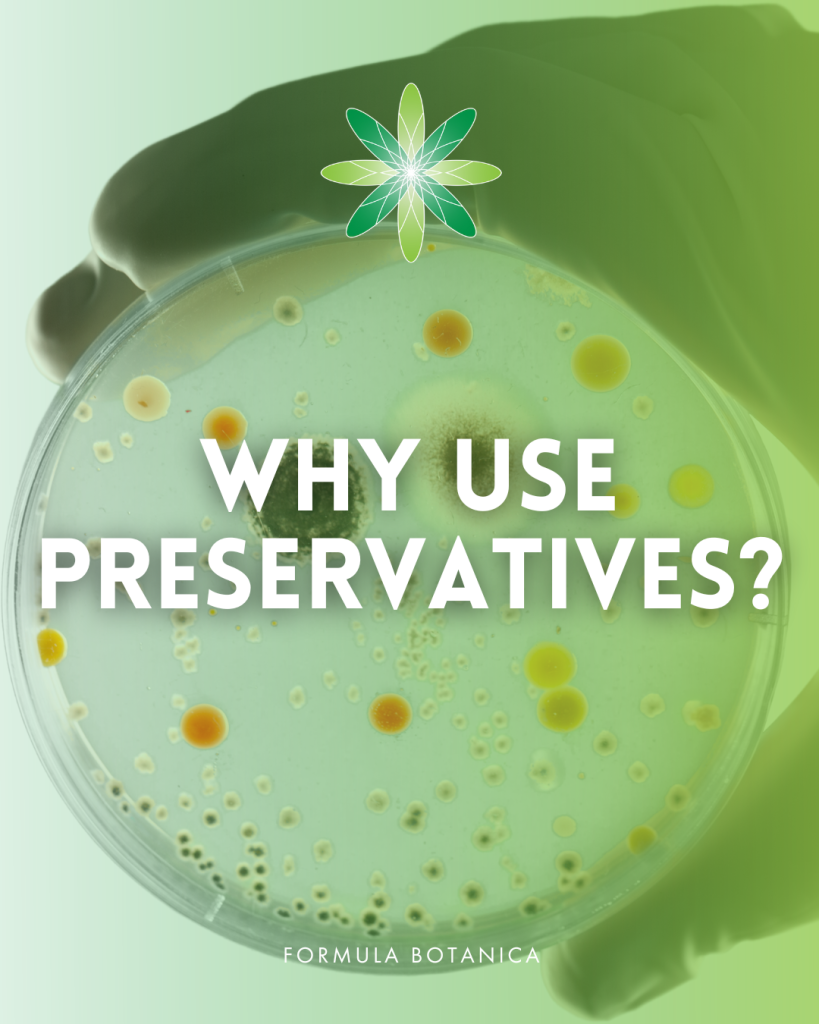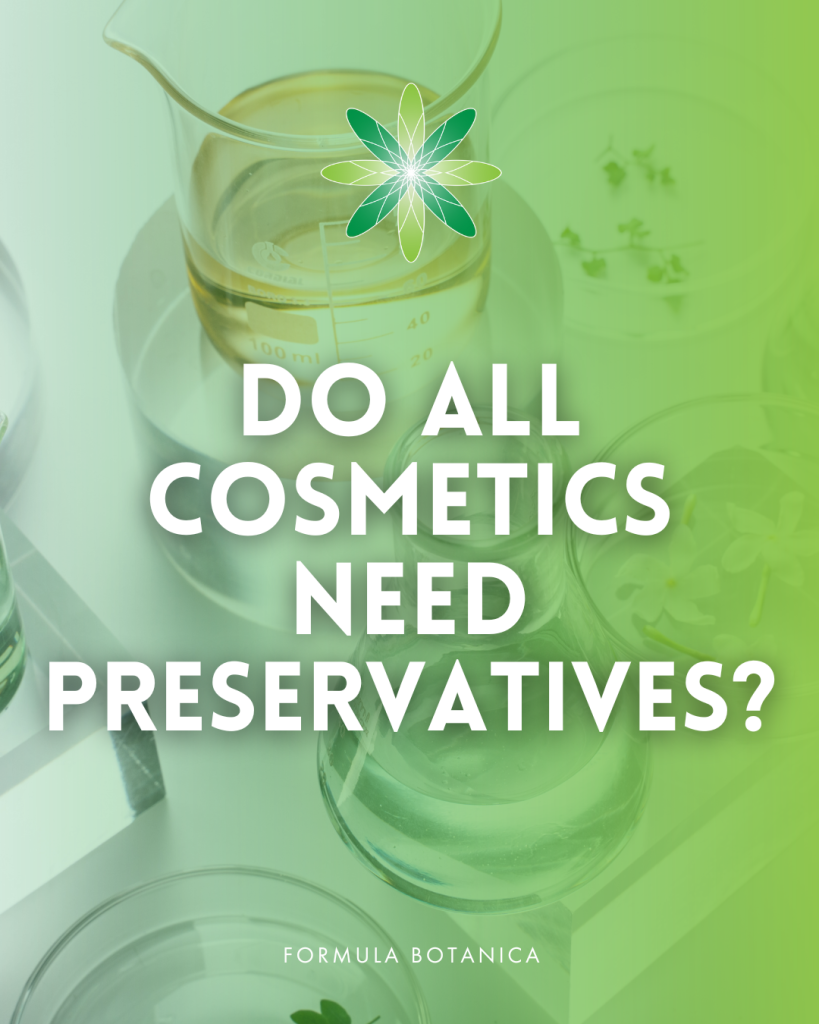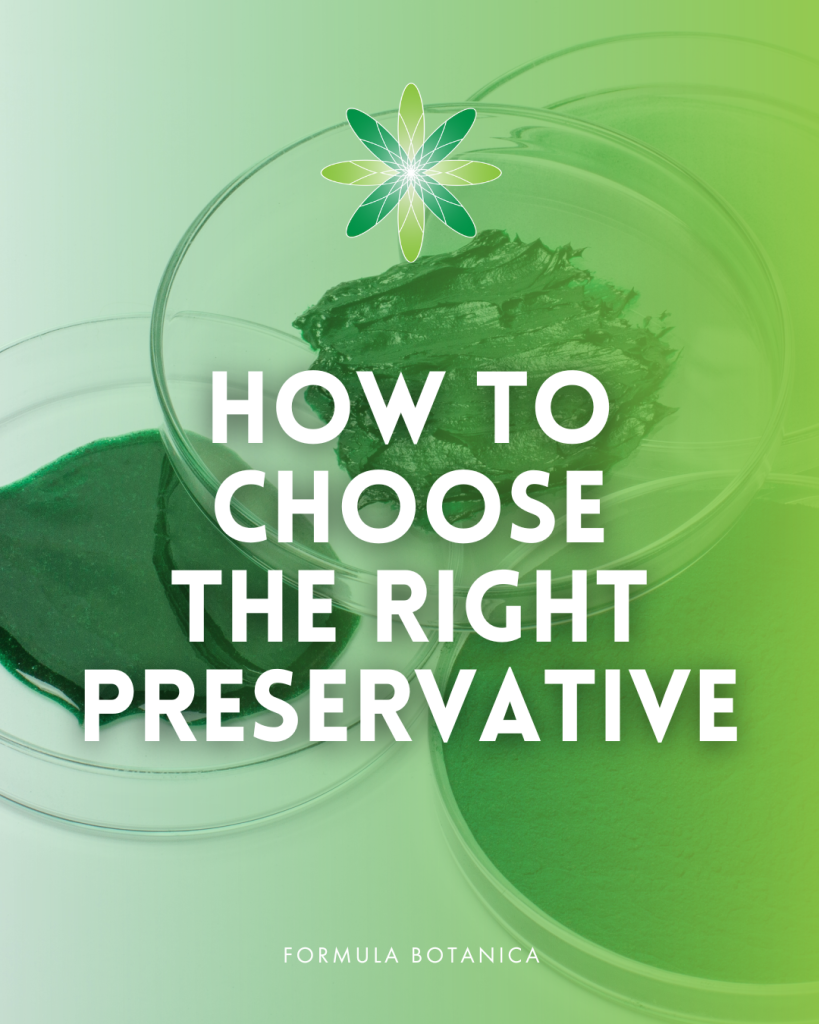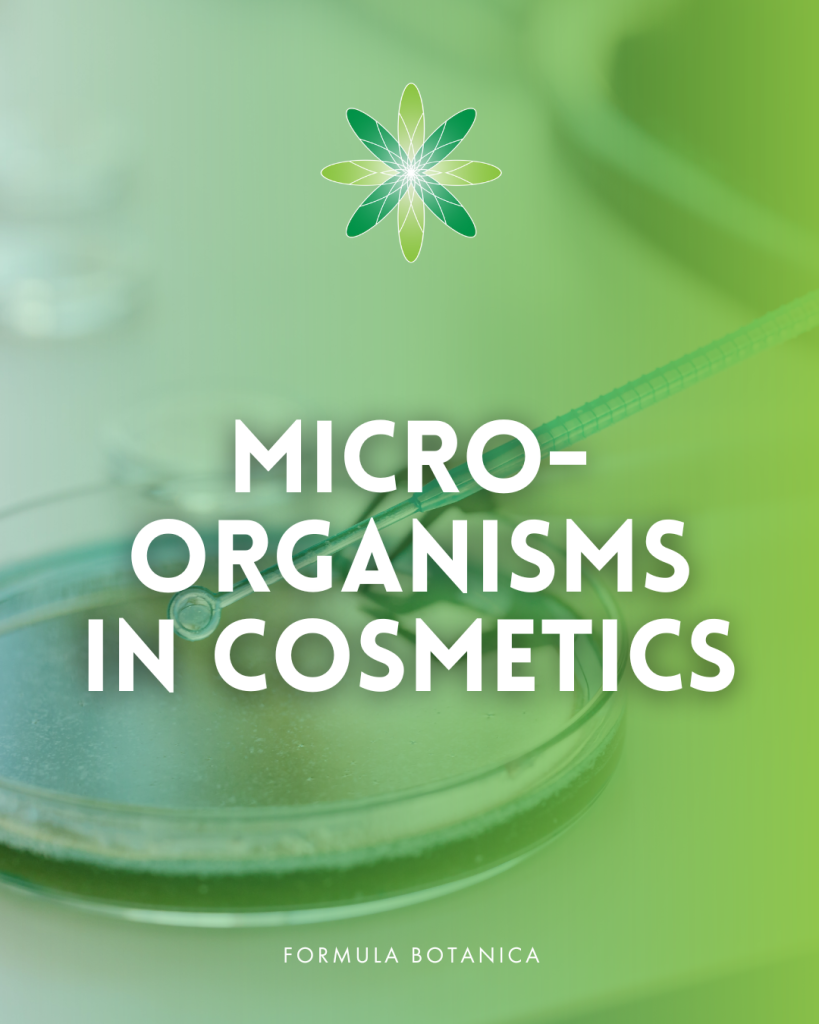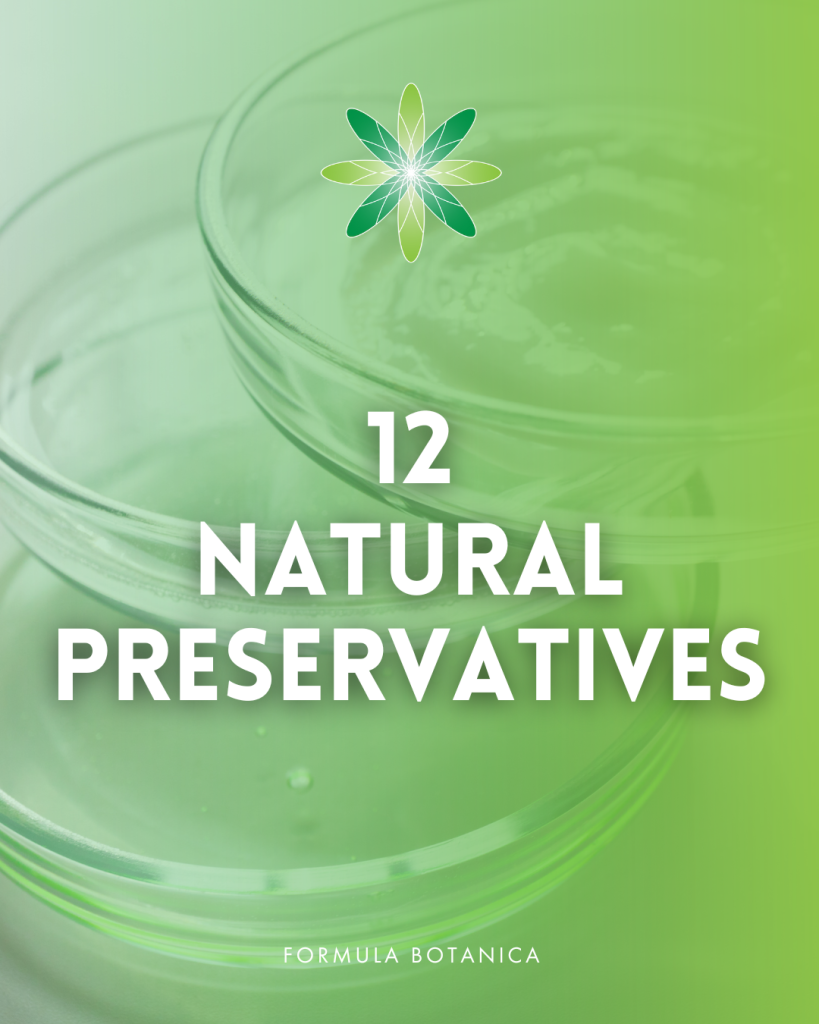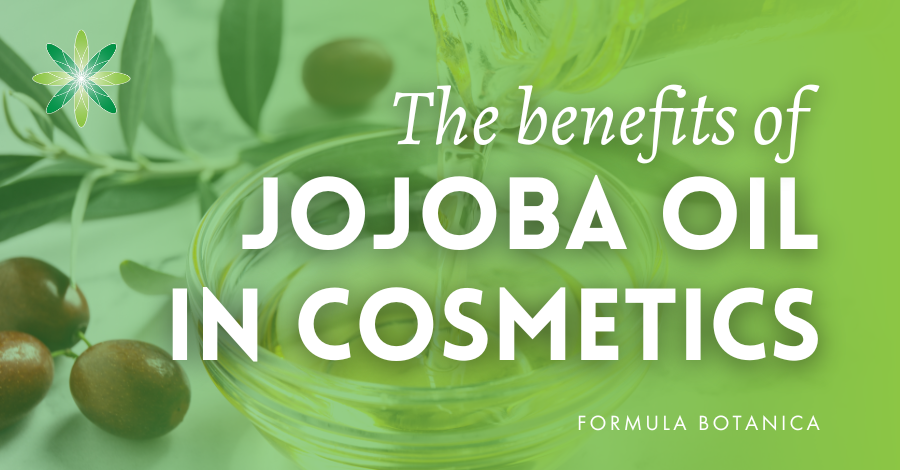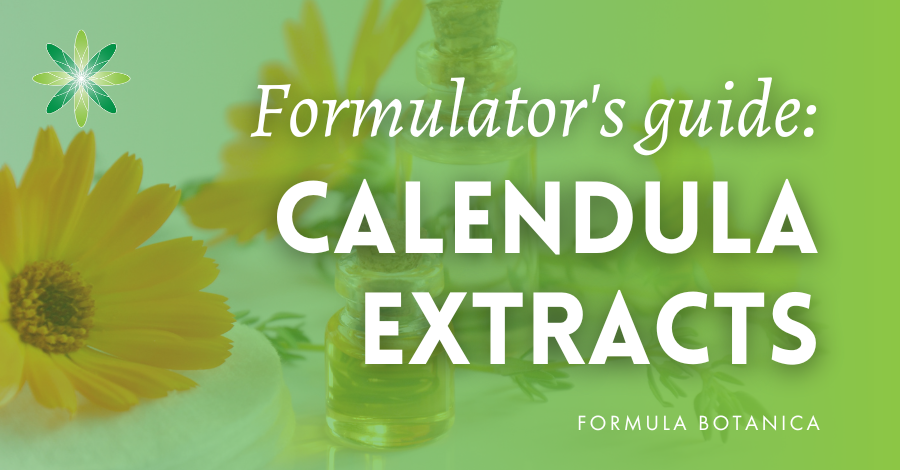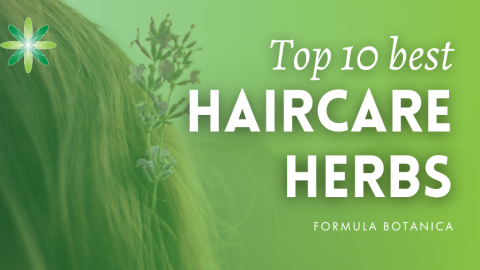Updated: 28.05.24
Natural preservatives are among the most controversial ingredients used in organic skincare and haircare. Natural formulators, and nowadays beauty consumers too, question the role of preservatives in cosmetics. Are they needed in certain formulations? Why are they so important? And, what happens if you don’t use preservatives in cosmetics?
Naturally-derived and natural preservatives are some of the least interesting, but most important ingredients in your organic skincare and haircare formulations. If only one small thing goes wrong with the preservation of your cosmetic formulations, you can jeopardise your customer’s health, your product and your business. This is a topic that most definitely deserves our attention
Quite often, students ask us which natural preservative is the best to use. We tell them that there is no distinct answer to this question as there are a number of factors to consider before coming to a conclusion about which natural preservative is best for your formulation. Preservatives’ efficacy depends largely on the conditions in which they are used.
Why You Should Use Natural Preservatives
Many skincare formulators are dubious about preservatives as they feel they may be using ingredients they view as risky and they don’t wish to endanger their customers. However, preservatives are a necessity in your water-based cosmetics because they protect your customer, your product and your business from disaster.
These links are must-reads to extend your knowledge on the use of preservatives:
5 Reasons why your natural formulations need preserving
How is this formulation preserved?
The potential side effects of skincare products
We continuously remind our students that…
The risk of using preservatives in cosmetic preparations is significantly lower than the risk of using unpreserved, water-based cosmetics.
The good news is, the list of natural preservatives continues to grow and there are many COSMOS and ECOCERT approved preservatives on the market now which means that you can continue to make preserved, compliant, water-based or water-containing natural and organic products with confidence.
Our list later in this post shows just how many there are now on the market serving a range of cosmetic product formulation needs.
Do all Natural Cosmetics need a Preservative?
Here, we must reiterate that the use of preservatives in skincare is absolutely essential if you are formulating something water-based. However, there are some products, mainly anhydrous formulations, that don’t require a preservative; these can be face oils, body butters and balms.
Anhydrous products are usually able to exist as ‘preservative-free’ systems as they are not prone to microbial contamination. However, products that have the risk of water being introduced to them by the user such as oil-based salt scrubs should also be taken into consideration when contemplating whether or not to include a preservative. Anhydrous products stored in the bathroom need preservatives because the bathroom environment is moist and warm, and these are optimum conditions for bacteria and mould to thrive.
How to Choose the Right Natural Preservatives
One of the main questions we are constantly asked at Formula Botanica is: “Which natural preservative should I use for my skincare formulation?“. There is no simple or standard answer to this question. In fact, it can easily become overwhelming to choose a natural preservative or preservative blend when you look at all the products available on the market and all the claims and promises made by suppliers and retailers.
Some of the main points to consider when choosing a preservative are:
- Solubility
- Preservation spectrum
- Working pH range
When you are designing a new organic skincare or haircare product, you must always consider which preservative to choose and how any of your natural preservatives might interact with the rest of the formulation. You must also determine whether any of your existing ingredients are already preserved.
Solubility
Determining the solubility of a preservative system is key to knowing which preservative you can add to a product. For example, adding an oil-soluble preservative to a facial toner primarily consisting of water is not going to provide the product with efficient protection.
Preservation spectrum
It is important to find a preservative system that is broad spectrum, meaning that it is effective against bacteria, mould and yeast.
Working pH range
This is the optimum range for the preservative; it is important to consider this when formulating as you want the best chances of preservation for your product. However, you must think about whether or not the preservative is compatible with the product you are formulating.
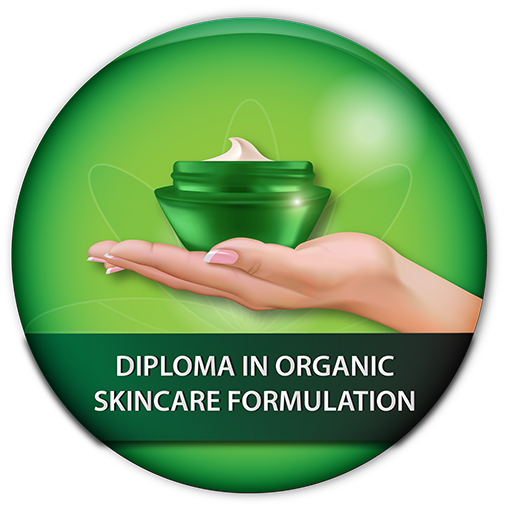
Do you want to learn how to make organic skincare that works?
Our award-winning foundational natural skincare course teaches you how to formulate organic skincare products and launch the beauty brand of your dreams. Click Here
Microorganisms in Cosmetic Formulations
Bacteria
Although many bacteria that come in contact with the skin are rendered harmless, some of them can cause irritations and infections on the skin and even in the eyes.
Mould
Mould is a type of fungus; it can be seen on food that’s gone bad. A similar situation will occur in cosmetics that haven’t been preserved or stored properly.
Yeast
Certain yeasts are well known for causing spoilage in the food industry and the same goes for yeasts in cosmetics.
See also our post and presentation:
16-point checklist on choosing a natural preservative for skincare
When Something Goes Wrong with Cosmetics Preservation
When something goes wrong with your natural preservatives, it could have disastrous consequences. You might have to re-call your entire batch, you might have to refund your customers, you might have to issue a public apology, you might suffer bad reviews, angry customers or even lawsuits. You don’t want to take any risks with your preservative system.
To ensure your products are protected, it is advisable to purchase a kit which will enable you to test the preservative efficacy in your artisan lab. Once you are ready to start producing your product and sharing it with the public, you will need to send it to an external testing laboratory to be challenge tested.
Read what happened when Liz Earle has to recall 15,000 cleansers
Learn to look for the 4 signs of product instability
Preservative Boosters
Preservative boosters are ingredients added to cosmetics to synergistically enhance the efficacy of preservatives. An example of this is the skin-conditioning active and wetting agent Glyceryl caprylate, commercially known as Dermosoft® GMCY. Wetting agents have a boosting effect on antimicrobial systems, particularly in combination with organic acids and other preservatives. They destabilise the cell membranes of the microorganisms and allow the organic acids or preservatives to penetrate more easily into the cell, thereby improving the activity against bacteria and yeast.
Antioxidant ingredients such as vitamin E and rosemary extract have been called ‘preservatives’, however, they are actually antioxidants. Antioxidants provide support to the preservation system by inhibiting oxidation to slow down the rate of rancidity of the product.
Formulation Tips for Natural Preservatives
- Consider the ideal pH of your product before choosing a preservative system.
- Include preservative boosters and antioxidants in your formulation.
- Always look through the information provided by the suppliers to determine the amount of preservative to use – one size does not fit all.
See also these related posts:
Top 10 Organic Formulation FAQs Answered
Are you buying contaminated hydrosols?
What can go wrong if you don’t control your formulation’s pH
12 Natural Preservatives for Cosmetic Formulation
Please note, this list is not exhaustive and will need to be cross-checked with supplier information should you choose to use one of the preservative systems listed below.
Verstatil® TBG MB
INCI: Triethyl Citrate, Glyceryl Caprylate, Benzoic Acid
Solubility: Insoluble in water
pH Stability: 4.0-6.0
Usage Level: 1.0-1.5%
Description
Verstatil® TBG MB is insoluble in water and requires a solubiliser to incorporate it into water-based products and emulsions. Verstatil® TBG MB is effective against Gram-positive and Gram-negative bacteria and yeast. However, it needs to be boosted in its action against mould in order to cover the full spectrum.
Euxyl® K903
INCI: Benzyl Alcohol, Benzoic Acid, Dehydroacetic Acid, Tocopherol
Solubility: Limited water solubility
pH Stability: 3 – 6 (efficacy is increased by reducing the pH. Recommended 5.0 – 5.5 or lower)
Usage Level: 0.4-1.2%
Description
Euxyl® K 903 is a liquid preservative for personal care products, with strong, broad-spectrum efficacy against bacteria, yeasts and moulds. This is a very effective preservative at low concentrations for all rinse-off and leave-on products. Since the preservative has lipophilic components, it is not completely water soluble; at 20°C, 100g of water can dissolve 1.2g of Euxyl® K 903. For water-based products, a solubiliser may be required to better incorporate it into water, however, it is best used in products that contain an oil phase.
Leucidal® SF MAX
INCI: Lactobacillus Ferment
Solubility: Water-soluble
pH Stability: 3.0-8.0
Usage Level: 2.0-4.0%
Description
Leucidal® Liquid SF MAX is a probiotic-based ingredient created by the fermentation of Lactobacillus in a defined growth medium. Leucidal® SF MAX provides broad-spectrum antimicrobial protection but is more effective when paired with a booster such as AMTicide Coconut for enhanced action against yeast and mould. Leucidal® SF Max can be used in a wide range of cosmetic products; however, to ensure optimum results it is recommended that it is incorporated into formulations at a pH between 3 and 8, during the cooling phase of the process at temperatures lower than 70°C.
Spectrastat™ G2 Natural MB
INCI: Caprylhydroxamic Acid, Glyceryl Caprylate, Glycerin
Solubility: Oil-soluble
pH Stability: 4.0-8.0
Usage Level: 1.5 – 2%
Description
Spectrastat™ G2 Natural MB is a 100% natural broad-spectrum alternative preservation system made from a blend of multi-functional ingredients. It is oil soluble and may be used in emulsion, anhydrous, and surfactant systems. These include creams, lotions, shower gels and make-up. It may be added in the final stage of formulation.
Optiphen™ BSB-N/Rokonsal™BSB-N
INCI: Benzyl Alcohol, Glycerin, Benzoic Acid, Sorbic Acid
Solubility: Miscible in water
pH Stability: Below 5.4
Usage Level: 0.3-1.0%
Description
Optiphen™ BSB-N/Rokonsal™BSB-N is a nature-identical preservative for cosmetics. It is a broad spectrum liquid preservative that is effective against Gram-negative bacteria, yeast and mould. Optiphen™ BSB-N/Rokonsal™BSB-N was specifically designed for formulations with a pH of up to 5.4 due to the presence of organic acids in its system. The lower the pH of the formulation, the better the efficacy of the preservative. It is ECOCERT, COSMOS, NATRUE and BDIH-compliant. Optiphen™ BSB-N/Rokonsal™BSB-N can be used in both O/W and W/O emulsions.
Optiphen™ BSB-W
INCI: Benzyl Alcohol, Aqua, Sodium Benzoate, Potassium Sorbate
Solubility: Water-soluble
pH Stability: up to 5.4
Usage Level: 0.3-1.0%
Description
Optiphen™ BSB-W is a nature-identical preservative for cosmetics, it is broad spectrum protecting against Gram-positive and Gram-negative bacteria, yeast and mould. It can be selected for natural or organic personal care products. This preservative supports a variety of natural personal care products. It is recommended for use in products with a pH of 5.4 or below. The lower the pH of the formulation, the better the efficacy of the preservative. It is ECOCERT, COSMOS, NATRUE and BDIH-compliant.
Geogard Ultra®
INCI: Gluconolactone, Sodium Benzoate
Solubility: Water-soluble
pH Stability: 3.0-6.0
Usage Level: 0.75-2.0%
Description
Geogard Ultra® is a synergistic, patented blend designed to provide broad-spectrum preservation in personal care and cosmetic formulations. It contributes an added skin moisturisation benefit to the product and conforms with COSMOS, NATRUE and the Soil Association. Geogard Ultra™ will preserve most water-based cosmetic formulations, including shampoos, lotions and creams. It works by slowly releasing gluconic acid over time, which helps contribute to the preservation.
EUXYL™ K712
INCI: Sodium Benzoate, Potassium Sorbate, Aqua
Solubility: Water-soluble
pH Stability: up to 5.5
Usage Level: 0.5-1.5%
Description
Euxyl™ k 712 preservative is a liquid preservative for personal care products, with strong, broad-spectrum effectiveness against bacteria, yeast and mold. This mild blend is compliant with many natural certification requirements. It is recommended for use in products with a pH of 5.5 or below. The lower the pH of the formulation, the better the efficacy of the preservative.
Cosphaderm® MultiMEG
INCI: Glyceryl Caprylate, Pentylene Glycol, Magnolia Officinalis Bark Extract
Solubility: Oil/alcohol soluble
pH Stability: 3.5-7.5
Usage Level: 1.2-1.6%
Description
Cosphaderm® MultiMEG is one of the multifunctionals that combine several properties to boost a formulation in different ways in addition to a high antimicrobial activity. None of these carefully selected substances are listed as preservatives in the EU Cosmetics Regulation, however they show strong efficiency against bacteria, yeast and mould.
Lexgard® Natural MB
INCI: Glyceryl Caprylate, Glyceryl Undecylenate
Solubility: Insoluble in water
pH Stability: 4.0-8.0
Usage Level: 1.0-1.5%
Description
Lexgard® Natural MB is an all-natural, multi-functional ingredient system as it also works as an emollient, co-emulsifier and skin re-fatting agent for self-preserving cosmetics. It is primarily effective against bacteria and yeast with some efficacy against mould, therefore it is best to combine it with a stronger yeast and mould agent. Lexgard® Natural MB has a pH range of 4.0-8.0 but has been shown to work best at pH 5.5. It is especially recommended in O/W or W/O emulsion systems such as skin care creams and lotions.
Geogard® ECT/Preservative ECO
INCI: Benzyl Alcohol, Salicylic Acid, Glycerin, Sorbic Acid
Solubility: Partially soluble in water
pH Stability: 3.0-8.0
Usage Level: 0.6-1.0%
Description
The Geogard® ECT/Preservative ECO blend’s novel composition offers broad-spectrum protection in a diverse range of products against Gram-positive and Gram-negative bacteria, yeast and moulds. It is a preservation system that meets the ECOCERT standards and is COSMOS-accepted and has a wide range of global regulatory acceptance. It is compatible with a wide range of skincare, hair care, and sun care systems, and it has a low odour and excellent safety profile. It is suitable for O/W emulsions, W/O emulsions and anhydrous products.
Dermosoft® 1388 ECO
INCI: Glycerin, Aqua, Sodium Levulinate, Sodium Anisate
Solubility: Water-soluble
pH Stability: 4.0-5.5
Usage Level: 2.0-4.0%
Description
Dermosoft® 1388 ECO is a 100% naturally derived, COSMOS-approved ingredient for natural cosmetics. It has very good microbial efficiency against Gram-positive bacteria, Gram-negative bacteria, yeasts and moulds. Dermosoft® 1388 ECO is suitable for all types of emulsions and surfactant-based products; it is also pH-sensitive. In emulsions, it has a synergistic boosting effect in combination with antimicrobial surface-active substances such as Dermosoft® GMCY (see above, where we mention preservative boosters) which helps to improve the performance of the preservative.
Would you like to make safe, effective and compliant cosmetics for friends or to sell? Our Diploma in Organic Skincare Formulation provides a comprehensive foundation to making natural cosmetics while our Certificate in Cosmetic Preservation gives you the confidence to work with natural preservatives across a range of formulation types.
FAQs
What are natural preservatives for skincare?
The safe preservation of cosmetics, especially natural cosmetics, is one of the most critical and challenging aspects of natural cosmetic formulation. Preservatives are required in cosmetics that are water-based or water-containing in order to prevent microbial contamination with the growth of yeasts, moulds and bacteria. There is an increasing number of commercially available preservatives that are considered compatible with natural and organic cosmetics; some are COSMOS and Ecocert certified. A typical natural preservative may use benzyl alcohol, salicylic acid, glycerin and sorbic acid to provide a broad-spectrum preservation system.
Is there a list of natural preservatives?
New, natural and nature-derived preservatives are coming on the market to respond to growing consumer demand and to the needs of the indie beauty business. This post on Everything you need to know about Natural Preservatives has a list of 12 trade name products that are considered compatible with natural, and often also organic cosmetic formulation. Several are COSMOS and Ecocert certified.
What is the safest preservative for natural cosmetics?
There is no single natural preservative that can be recommended as safe or suited to all-natural cosmetic formulations. Preservative systems are highly dependent on the type of formulation, such as whether it is an emulsion or anhydrous. They also work within narrow pH ranges and have different solubility and compatibility with other ingredients in a formulation. Cosmetic formulators must consider these and a host of other factors, such as their products’ stability, usage and desired shelf life when deciding which preservative is the safest and best option for a product.
Do all cosmetics need preservatives?
Cosmetics containing water or which are water-based need a preservative. When a cosmetic product’s pH can be measured, a preservative is required. Anhydrous products such as balms, body and face oils and butters generally do not need a preservative. However, if an anhydrous product is likely to be exposed to water, such as when hands are dipped in or it is left opened in a damp bathroom, it should contain a preservative to prevent its contamination. Products with a high percentage of alcohol, such as fragrances, may contain a very small percentage of water (generally no more than 3-5%) without needing a preservative as the alcohol acts as a preservative.
Where can I learn to formulate natural skincare?
Join us at Formula Botanica, where tens of thousands of students and followers take our free and paid online courses to learn how to formulate organic skincare and haircare for themselves or to sell and also how to set up a beauty brand and business.
FREE TRAINING
Learn how to become an
Organic Skincare Formulator
FREE TRAINING
How to become an
Organic Skincare Entrepreneur
FREE TRAINING
How to become an
Organic Skincare Entrepreneur
Leave us a comment
Lorraine Dallmeier is a Biologist, Chartered Environmentalist and the CEO of Formula Botanica, the award-winning online organic cosmetic science school. Read more about Lorraine and the Formula Botanica Team.


